
Carl Andrew Spaatz, nicknamed "Tooey", was an American World War II general. As commander of Strategic Air Forces in Europe in 1944, he successfully pressed for the bombing of the enemy's oil production facilities as a priority over other targets. He became Chief of Staff of the newly formed United States Air Force in 1947.

General (Honorary) Ira Clarence Eaker was a general of the United States Army Air Forces during World War II. Eaker, as second-in-command of the prospective Eighth Air Force, was sent to England to form and organize its bomber command. While he struggled to build up airpower in England, the organization of the Army Air Forces evolved and he was named commander of the Eighth Air Force on December 1, 1942.
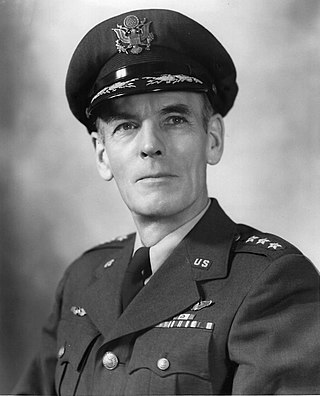
Lieutenant General Hubert Reilly Harmon, after a distinguished combat career in World War II, was instrumental in developing plans for the establishment of the United States Air Force Academy. He was the first superintendent of the academy and was one of the persons most influential in establishing it as a successful educational institution.

Major General Clayton Lawrence Bissell was an air officer in the United States Army and United States Army Air Forces during World War I and World War II.
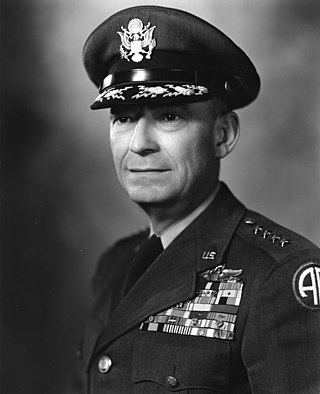
Joseph Taggart McNarney was a four-star general in the United States Army and in the United States Air Force, who served as Military Governor of occupied Germany.

The Aviation Section, Signal Corps, was the aerial warfare service of the United States from 1914 to 1918, and a direct statutory ancestor of the United States Air Force. It absorbed and replaced the Aeronautical Division, Signal Corps, and conducted the activities of Army aviation until its statutory responsibilities were suspended by President Woodrow Wilson in 1918. The Aviation Section organized the first squadrons of the aviation arm and conducted the first military operations by United States aviation on foreign soil.

Ralph Francis Stearley, CBE, was a United States Army and Air Force officer. He is best known as a general in the United States Army Air Forces during World War II. Stearly was born at Brazil, Indiana, in 1898. He graduated from the United States Military Academy at West Point, New York, and was commissioned a second lieutenant in the cavalry on November 1, 1918. He transferred to the Air Service in 1925 and commanded the IX Tactical Air Command during the last two months of the war in Europe, supporting the United States First Army during combat operations in Europe.

General John Kenneth Cannon was a World War II Mediterranean combat commander and former chief of United States Air Forces in Europe for whom Cannon Air Force Base, Clovis, New Mexico, is named.

Frederic Harrison Smith Jr. was a United States Air Force four-star general who served as Commander in Chief, U.S. Air Forces in Europe (CINCUSAFE) from 1959 to 1961; and Vice Chief of Staff, U.S. Air Force (VCSAF) from 1961 to 1962.

Lieutenant General Charles Bertody Stone III was an officer in the US Air Force. During World War II, he served as Chief of Staff, Headquarters Army Air Forces, China-Burma-India Theater. During the Cold War, he served as Commander, Continental Air Command, Mitchel Field, New York between 1955-1957.
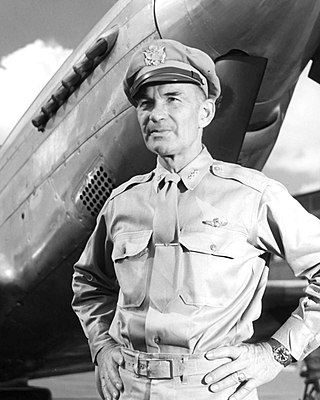
Millard Fillmore Harmon Jr. was a lieutenant general in the United States Army Air Forces during the Pacific campaign in World War II. He was presumed to have perished in February 1945 on a flight when the plane carrying him disappeared in transit.
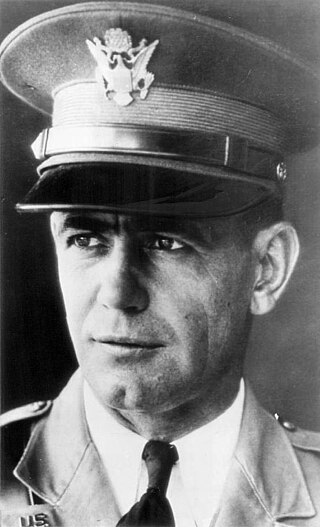
Harold Huston George was a general officer in the United States Army Air Forces during World War II. He began his military career before World War I when he enlisted as a private in the 3rd New York Infantry Regiment. Joining the Air Service, he became an ace in France in 1918, credited with five aerial victories.

General Walter Campbell Sweeney Jr. was a four-star general in the United States Air Force (USAF) who served as commander of Tactical Air Command.

Ralph Royce was a United States Army Air Forces general during World War II. A West Point graduate who learned to fly in 1915–16, he served with the 1st Aero Squadron in the Pancho Villa Expedition and later led it on the Western Front. During World War II as a brigadier general, he led the Royce special mission to Mindanao, in which a small force of bombers flew from Australia to attack Japanese targets in the Philippines. Later he was Deputy Commander of the Ninth Air Force and commanded the 1st Provisional Tactical Air Force.

Richard Condie Sanders was the youngest general officer in the history of the United States Air Force. Born in 1915, in Salt Lake City, Utah, he graduated from the University of Utah in 1937, with a Bachelor of Science degree, and was appointed a second lieutenant, Field Artillery Reserve on September 4, 1936, while still in college. He served on extended active duty from July 28, 1937, to June 30, 1938, and from July 5, 1938, to September 30, 1938. He then enlisted as a flying cadet on October 4, 1938, and, on completion of his training, was commissioned a second lieutenant, Air Reserve, on August 25, 1939. He was called to active duty the next day and was commissioned a second lieutenant, Air Corps, Regular Army, on July 1, 1940.

Thomas Carl Richards was a general in the United States Air Force and the former chief of staff of the Supreme Headquarters Allied Powers Europe.

Clements McMullen was an American Air Force major general whose last assignment was deputy commander, Strategic Air Command, headquartered at Offutt Air Force Base, Nebraska. He assumed this position January 10, 1947 and served until October 25, 1948.

Ralph Pittman Cousins was a United States Army major general Born in Mexia, Texas, he graduated from the United States Military Academy in 1915. He served in the Cavalry before transferring to the United States Army Air Corps. He served in a variety of command positions in the newly created air service of the United States Army and was instrumental in designing the model for what would become the commercial aviation system. Schools under his command trained many of the aircrews who served in all theaters of World War II. After retiring from the army, he became a businessman. Cousins died in 1964 and he was memorialized as an air pioneer who helped bring American air power from it beginnings to its power in World War II.
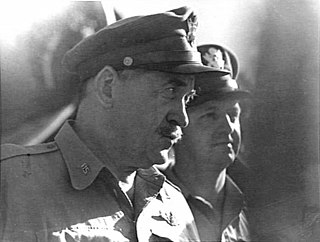
Martin Francis Scanlon was a general officer in the United States Air Force during World War II.

Davenport Johnson was a United States Army Air Forces major general. During World War II, he commanded the Eleventh Air Force in Alaska from November 1943 to November 1945.


















